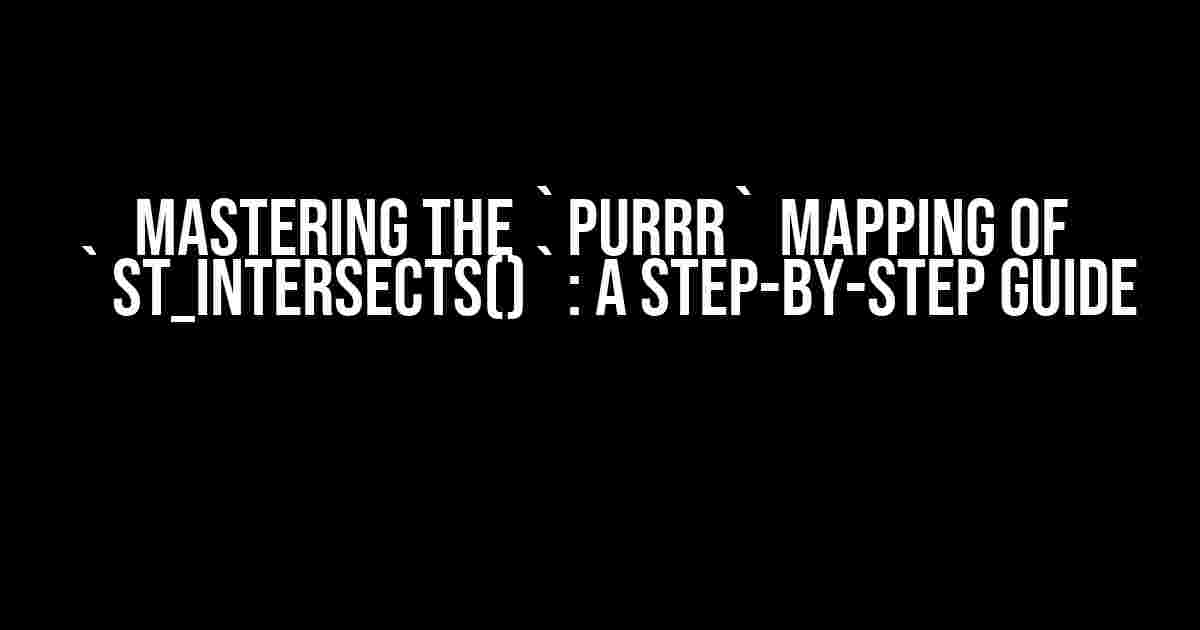Are you tired of struggling with spatial joins in R? Do you want to unlock the full potential of your spatial data? Look no further! In this comprehensive guide, we’ll dive into the world of `purrr` mapping and `st_intersects()` to perform spatial joins using inputs from across two lists.
- What is `st_intersects()` and Why Do We Need It?
- Preparation is Key: Setting Up Your Data
- The `purrr` Mapping Magic: Using `map()` and `st_intersects()`
- Understanding the Output: A Closer Look at `result_list`
- Real-World Applications: Putting `purrr` Mapping to Work
- Conclusion: Unlocking the Power of `purrr` Mapping and `st_intersects()`
What is `st_intersects()` and Why Do We Need It?
`st_intersects()` is a powerful function from the `sf` package that allows us to perform spatial intersections between two sets of spatial objects. It’s a fundamental operation in spatial analysis, enabling us to identify the relationships between different spatial features.
However, when working with large datasets, using `st_intersects()` can become cumbersome and inefficient. This is where `purrr` comes to the rescue! By leveraging the `map()` function from the `purrr` package, we can elegantly perform spatial joins using inputs from across two lists.
Preparation is Key: Setting Up Your Data
Before we dive into the `purrr` magic, let’s prepare our data. Assume we have two lists of spatial objects: `list_A` and `list_B`. Each list contains multiple spatial objects, which can be polygons, points, or lines.
library(sf)
library(purrr)
# Create sample data
list_A <- list(
poly1 = st_polygon(list(c(0, 0, 1, 1, 0))),
poly2 = st_polygon(list(c(1, 1, 2, 2, 1))),
poly3 = st_polygon(list(c(2, 2, 3, 3, 2)))
)
list_B <- list(
poly4 = st_polygon(list(c(0.5, 0.5, 1.5, 1.5, 0.5))),
poly5 = st_polygon(list(c(1.5, 1.5, 2.5, 2.5, 1.5))),
poly6 = st_polygon(list(c(2.5, 2.5, 3.5, 3.5, 2.5)))
)
The `purrr` Mapping Magic: Using `map()` and `st_intersects()`
Now, let’s use `purrr` to perform the spatial join. We’ll create a new list, `result_list`, that will store the intersection results.
result_list <- map(list_A, ~st_intersects(.x, list_B))
Here’s what’s happening behind the scenes: `map()` takes each element from `list_A` and applies the `st_intersects()` function to it, using `list_B` as the second argument. The resulting list, `result_list`, contains the intersection results for each pair of spatial objects.
Understanding the Output: A Closer Look at `result_list`
Let’s take a closer look at the `result_list` output:
result_list
#> $poly1
#> [1] TRUE TRUE FALSE
#>
#> $poly2
#> [1] TRUE TRUE TRUE
#>
#> $poly3
#> [1] FALSE TRUE TRUE
Each element in `result_list` corresponds to a spatial object from `list_A`. The values represent the intersection results with each spatial object in `list_B`. In this case, we have three spatial objects in `list_A`, each with three intersection results.
Deciphering the Intersection Results
To make the most of our spatial join, let’s break down the intersection results:
- `TRUE` indicates an intersection between the two spatial objects.
- `FALSE` indicates no intersection between the two spatial objects.
In our example, `poly1` from `list_A` intersects with `poly4` and `poly5` from `list_B`, but not with `poly6`. Similarly, `poly2` from `list_A` intersects with all three spatial objects in `list_B`, while `poly3` only intersects with `poly5` and `poly6`.
Real-World Applications: Putting `purrr` Mapping to Work
Now that we’ve mastered the `purrr` mapping of `st_intersects()`, let’s explore some real-world applications:
Environmental Monitoring
In environmental monitoring, we might want to identify areas where wildlife habitats overlap with human settlements. By using `purrr` mapping and `st_intersects()`, we can efficiently perform spatial joins to identify these areas of overlap.
Urban Planning
In urban planning, we might want to analyze the relationships between different land uses, such as residential areas, commercial zones, and parks. By using `purrr` mapping and `st_intersects()`, we can quickly identify areas where different land uses intersect or overlap.
Epidemiology
In epidemiology, we might want to study the relationships between disease outbreaks and environmental factors, such as proximity to water sources or agricultural areas. By using `purrr` mapping and `st_intersects()`, we can efficiently identify areas where disease outbreaks coincide with environmental factors.
Conclusion: Unlocking the Power of `purrr` Mapping and `st_intersects()`
In this comprehensive guide, we’ve demonstrated the power of combining `purrr` mapping with `st_intersects()` to perform efficient and scalable spatial joins. By mastering this technique, you’ll be able to unlock new insights from your spatial data and tackle complex problems with ease.
Remember, the `purrr` mapping of `st_intersects()` is a versatile tool that can be applied to a wide range of spatial analysis tasks. With practice and creativity, the possibilities are endless!
| Function | Description |
|---|---|
| `st_intersects()` | Performs spatial intersection between two sets of spatial objects |
| `map()` | Applies a function to each element of a list and returns a new list |
| `purrr` | A package for functional programming and data manipulation in R |
| `sf` | A package for simple features in R, providing classes for spatial data |
Happy mapping!
Frequently Asked Question
Get insights on using the `purrr` mapping of `st_intersects()` with inputs from across two lists!
What is the main purpose of using purrr mapping with st_intersects()?
The main purpose of using purrr mapping with st_intersects() is to perform spatial intersection operations between two sets of spatial objects, where each set is stored in a separate list. This approach allows for efficient and concise handling of complex spatial operations.
How do I input the two lists into the purrr mapping function?
You can input the two lists into the purrr mapping function using the `map2()` function, which takes two lists as input and applies the st_intersects() function element-wise to corresponding elements from each list.
What is the advantage of using purrr mapping over traditional looping methods?
Using purrr mapping provides a more concise and expressive way of performing spatial operations, which can be easier to read and maintain than traditional looping methods. Additionally, purrr mapping can take advantage of vectorized operations, making it more efficient for large datasets.
How can I customize the output of the purrr mapping with st_intersects()?
You can customize the output of the purrr mapping with st_intersects() by using additional arguments within the mapping function, such as specifying the type of intersection operation or handling missing values. You can also use post-processing functions to further manipulate the output.
What are some common use cases for purrr mapping with st_intersects()?
Purrr mapping with st_intersects() is commonly used in spatial analysis tasks, such as identifying overlapping areas between different boundaries, finding proximity relationships between features, or performing spatial joins between datasets.



